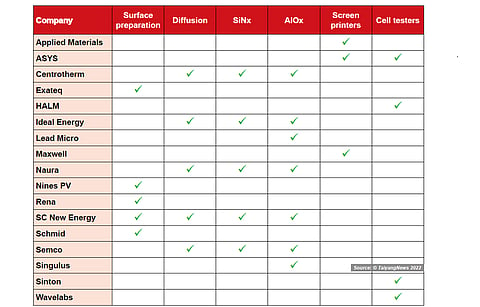

PERC solar cell processing can be largely broken down into 5 steps:
Each of 5 steps in cell processing has a specific role. To start with, the surface preparation step has 2 main functions – removing saw damage and reducing the reflectivity of the wafer surface. This is mainly accomplished with wet benches, while there is also a dry etching solution available. In addition to etching and texturization, though not immediately after, wet-chemical tools are also used to clean the wafers from undesired side-effects from the diffusion process, such as for removal of phosphorus silicate glass (PSG), edge isolation to remove the phosphorus diffusion on wafer rims as well as on the rear side. Wet benches are also used for rear polishing of the wafers, a step often integrated into edge isolation tools.
After the saw damage etching (SDE) and texturing, wafers are subjected to diffusion to form the emitter. Diffusion furnaces are the workhorse for emitter formation; however, the dopant can also be introduced with ion implantation, while thermal furnaces are still required to activate the dopant.
Passivation is mainly done by depositing the dielectric films on the wafer surface. The silicon nitride deposition, typically accomplished with PECVD furnaces, is used for passivation of the n-type surface, while the rear surface is passivated with a stack of aluminum oxide and silicon nitride. PECVD and ALD are the two mainstream technologies widely used for applying the rear surface passivation stack for PERC cells
Metallization is the next step in which the metallic contacts are applied to collect the generated charge carriers. Screen printing is the current state of the art for metallization, while several advanced printing technologies such as dispensing have been under development for several years. Most of the advanced printing technologies are still based on applying metallic silver on the solar cell surface. Plating is an alternative technology that has been around for the same application, but yet has to see commercial success.
All the efforts put into improving the solar cell are only evident at the testing station, where the IV characteristics of a solar cell are measured. Thus, a precise measurement setup is equally important. Tool vendors are coming up with different ways to simulate the sun indoors with various testing procedures to precisely assess the electrical parameters of the solar cells. While there are a few more sub-processes and additional steps involved in converting a silicon wafer into a solar cell, the ones mentioned above are the key. Thus, the current market survey is also limited to covering the production tools used in those 5 processing steps (see: Progress In Cell Production Equipment Segment).
That said, unlike the typical TaiyangNews survey, we are not covering the segment completely, especially the number of companies. The breadth of coverage of production tools is already quite extensive. Our focus here has been mainly about garnering insights from technology leaders, rather than providing complete coverage of the players in the respective segments. However, we make sure that every section has a representation from the market leaders. This survey features specs for 53 products from 17 companies.
The survey is split into 5 main sections, featuring 8 different tool technology platforms (equipment types and corresponding tables), given that some processes have different tool platforms. For example, in surface preparation, there are various applications for wet-benches — tools for texturing and PSG etch and edge isolation. Then, in passivation, especially the aluminum oxide deposition can be done with ALD or PECVD. The below table summarizes the tool makers and their corresponding equipment platforms.
